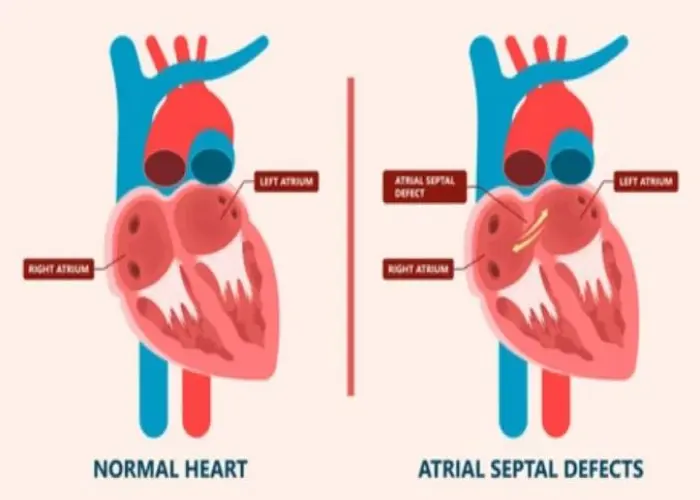 Welcome
Welcome
“May all be happy, may all be healed, may all be at peace and may no one ever suffer."
Eisenmenger syndrome

Eisenmenger syndrome is a condition that develops as a result of a congenital heart defect. The defect causes abnormal blood flow within the heart, which can lead to high blood pressure in the lungs (pulmonary hypertension). Over time, this can cause permanent damage to the blood vessels in the lungs and lead to Eisenmenger syndrome.
In Eisenmenger syndrome, the high pressure in the lungs causes blood to flow from the right side of the heart into the left side, instead of the other way around. This can cause cyanosis (a bluish discoloration of the skin and mucous membranes due to lack of oxygen) and shortness of breath. Other symptoms can include fatigue, dizziness, and chest pain.
Eisenmenger syndrome is typically diagnosed through imaging tests such as echocardiography and cardiac catheterization. Treatment may involve medications to manage symptoms and improve heart function, such as diuretics, oxygen therapy, and drugs that dilate blood vessels. In some cases, surgery or heart and lung transplantation may be necessary.
Prevention of Eisenmenger syndrome involves early detection and treatment of congenital heart defects that can lead to the condition. It is important for individuals with congenital heart defects to receive regular medical care and follow the treatment plan recommended by their healthcare providers to prevent complications and improve quality of life.
Research Papers
Disease Signs and Symptoms
- Gray ashy skin
- Irregular heartbeats (arrhythmia)
- Headaches
- Numbness
- Fainting (syncope)
- Dizziness (vertigo)
- Heart disease
- Chest tightness
- Chest pain
- Shortness of breath (dyspnea)
- Fingertips spread out and become rounder than normal (Clubbing of fingers)
- Numbness or tingling in fingers or toes
Disease Causes
Eisenmenger syndrome
Eisenmenger syndrome usually develops due to a hole between the chambers of your heart. To understand how Eisenmenger syndrome affects your heart and lungs, it's helpful to know how your heart works.
How the heart works
Your heart is divided into four chambers, two on the right and two on the left. The right side moves blood into vessels that lead to your lungs. In your lungs, oxygen enriches your blood, which then circulates to your heart's left side. The left side of your heart pumps blood into a large vessel called the aorta, which circulates blood to the rest of your body.
Valves control the flow of blood into and out of the chambers of your heart. These valves open to allow blood to move to the next chamber or to one of the arteries, and then close to keep blood from flowing backward.
How Eisenmenger syndrome develops
Eisenmenger syndrome is typically due to an unrepaired hole (shunt) between the main blood vessels or chambers of your heart. This shunt is a heart defect you're born with (congenital). Heart defects that can cause Eisenmenger syndrome include:
- Atrioventricular canal defect. In this heart defect, there's a large hole in the center of the heart where the walls between the upper chambers (atria) and lower chambers (ventricles) meet. Some of the valves in your heart also may not function properly.
- Atrial septal defect. An atrial septal defect is a shunt in the wall of tissue that divides the right and left sides of the upper chambers of your heart (atria).
- Patent ductus arteriosus. This heart defect is an opening between the pulmonary artery that carries oxygen-poor blood to the lungs and the artery that carries oxygen-rich blood to the rest of your body (aorta).
- Ventricular septal defect. This shunt in the wall of tissue that divides the right and left sides of your heart's main pumping chambers (ventricles) is the most common cause of Eisenmenger syndrome.
In any of these defects, blood is flowing in a way it normally doesn't, which increases the pressure in your pulmonary artery. Over time, this increased pressure damages the smaller blood vessels in your lungs. The damaged blood vessel walls make it difficult to pump blood to the lungs.
Eisenmenger syndrome causes increased blood pressure in the side of the heart that has low oxygen-containing blood (blue blood). This allows the low oxygen-containing blood to cross the hole (shunt) in the heart or blood vessels, which lets oxygen-rich and oxygen-poor blood mix. This lowers the oxygen level in your blood and causes a bluish tint to your skin (cyanosis). This also leads to an increase in your red blood cell count to try to make up for the lack of oxygen.
Disease Prevents
Disease Treatments
Eisenmenger syndrome treatment is aimed at controlling your or your child's symptoms and managing the condition. Although there's no cure, medications may help you feel better, improve your quality of life and prevent serious complications.
Doctors don't recommend surgery to repair the hole in your heart once Eisenmenger syndrome has developed, because any surgery may be life-threatening. It's important that you see a doctor who has expertise in Eisenmenger syndrome.
Observation and monitoring
You'll be monitored through regular visits with a congenital heart disease cardiologist. You should have an appointment with your cardiologist at least once a year. A typical evaluation generally includes a thorough review of complaints and symptoms, a physical exam, blood tests, and additional heart-health tests.
Medications
Medications are the primary treatment for Eisenmenger syndrome. You'll need to be monitored closely by a doctor when taking medications for any changes in blood pressure, fluid levels and your pulse rate.
Medications for Eisenmenger syndrome include:
- Medications to control irregular heart rhythms. If you have an irregular heartbeat, you may receive medications to control your heart rhythms.
- Iron supplements. Your doctor may prescribe iron supplements if your iron level is too low. But don't start taking iron supplements without talking to your doctor first.
- Aspirin or other blood-thinning medications. If you have had a stroke, blood clot or certain types of irregular heart rhythms, your doctor may recommend aspirin or other blood thinners such as warfarin (Jantoven). However, people who have Eisenmenger syndrome are also at increased risk of bleeding when taking these medications, so don't take any blood thinners unless your doctor tells you to do so. Don't take over-the-counter pain medications, such as ibuprofen (Advil, Motrin IB, others) or naproxen sodium (Aleve, others), without talking to your doctor first.
- Medication that relaxes blood vessel walls. Drugs called endothelin receptor antagonists are medications that reverse the effect of endothelin, a substance in the walls of blood vessels that causes them to narrow. One of these medications, bosentan (Tracleer), may improve your energy level and symptoms by lowering the resistance in your lung arteries. If you take bosentan, you'll need monthly liver monitoring because the drug can damage your liver.
- Sildenafil and tadalafil. Sildenafil (Revatio, Viagra) and tadalafil (Cialis, Adcirca) are sometimes used to treat high blood pressure in your pulmonary arteries caused by Eisenmenger syndrome. These drugs work by opening the blood vessels in the lungs to allow blood to flow through more easily. Side effects include upset stomach, dizziness and vision problems.
- Antibiotics. Depending on your condition, you may need to take antibiotics before having certain dental and medical procedures. These procedures may allow bacteria to enter your bloodstream. Antibiotics taken before these procedures can help destroy or control the harmful bacteria that may lead to an infection of your heart's tissues (endocarditis).
Surgeries or other procedures
If your red blood cell count becomes too high and is causing symptoms such as headache, difficulty concentrating or vision problems, your doctor may recommend having blood drawn to help decrease your blood cell counts. The blood draw procedure is called phlebotomy. It should not be done routinely and should only be done after consultation with a congenital heart disease expert. You should receive IV fluids when having blood drawn to help replace the lost fluids.
Some people who have Eisenmenger syndrome may eventually need a heart and lung transplant or a lung transplant with repair of the hole in the heart if other treatments don't control your symptoms.
Disease Diagnoses
Disease Allopathic Generics
Disease Ayurvedic Generics
Disease Homeopathic Generics
Disease yoga
Eisenmenger syndrome and Learn More about Diseases

Sarcoidosis

Chiari malformation

Corns and calluses

Factitious disorder

Atrial septal defect (ASD)

Tonsillitis

Prader-Willi syndrome

Subconjunctival hemorrhage (Broken blood vessel in eye)
eisenmenger syndrome, আইজেনমেনজার সিন্ড্রোম
To be happy, beautiful, healthy, wealthy, hale and long-lived stay with DM3S.
